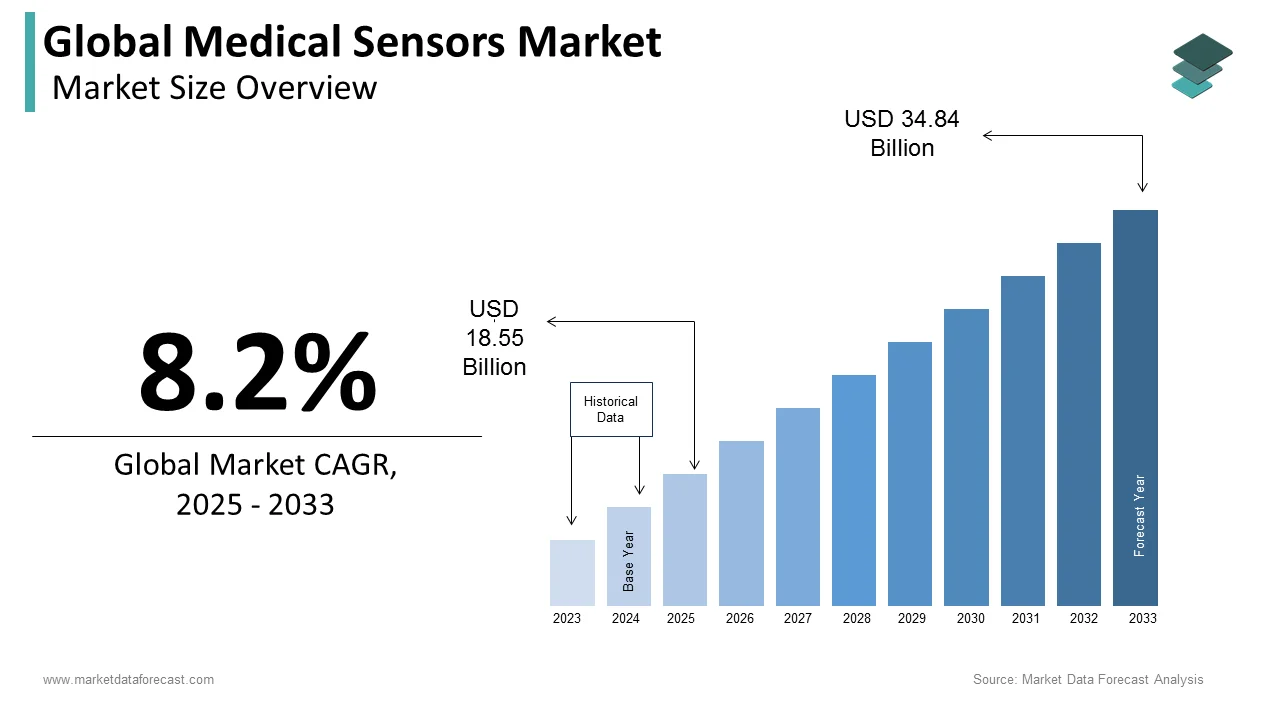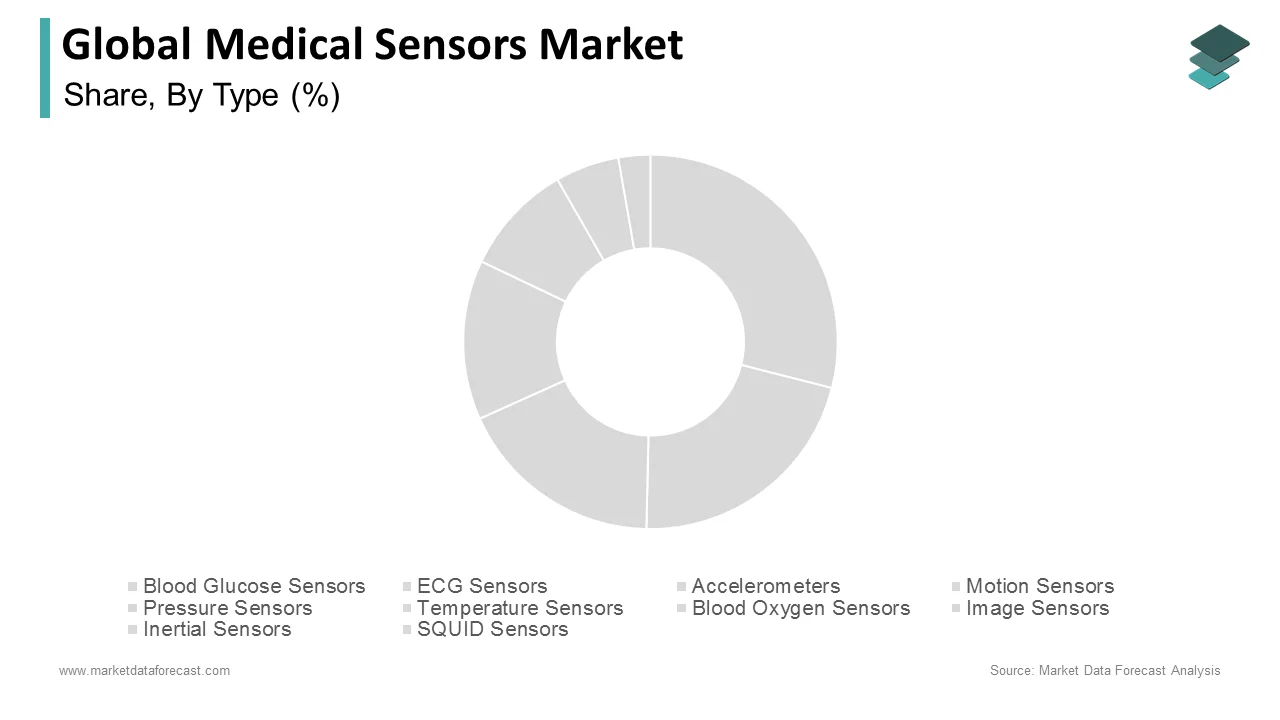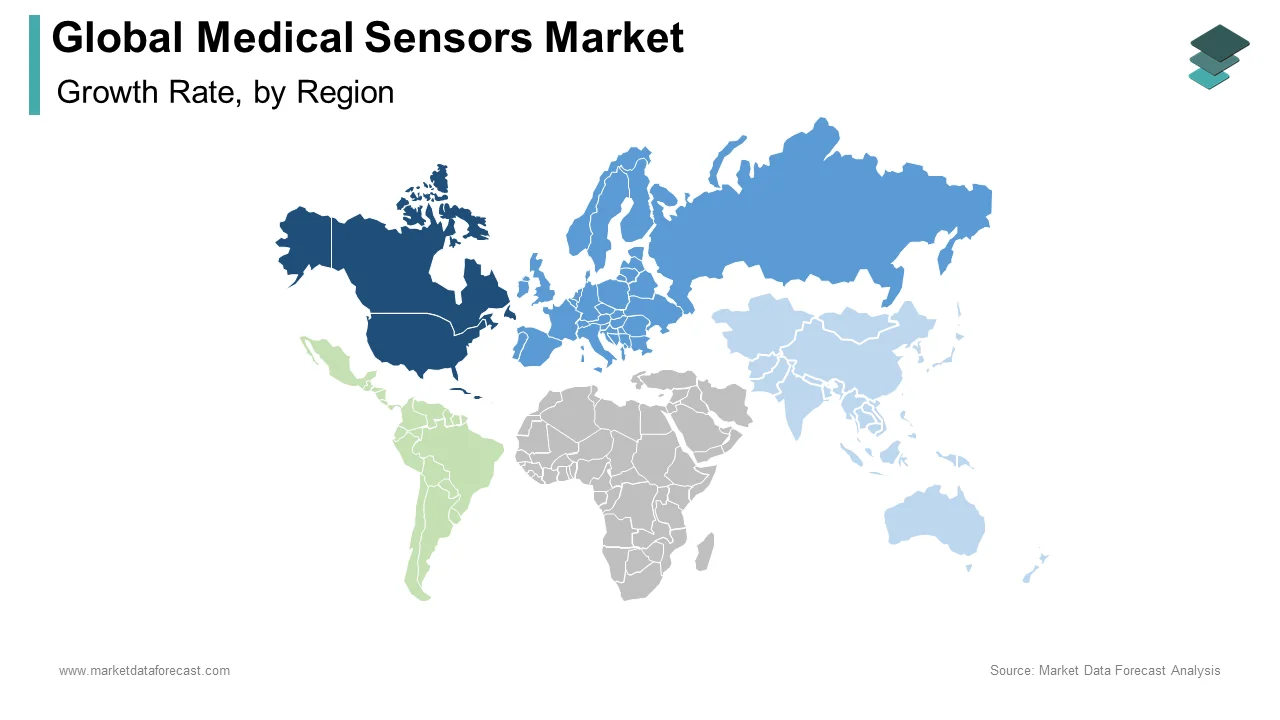Global Medical Sensors Market Size, Share, Trends & Growth Forecast Report By Type, Application, Technology and Region (North America, Europe, Asia-Pacific, Latin America, Middle East and Africa), Industry Analysis From 2025 To 2033.
Global Medical Sensors Market Size
The global medical sensors market was valued at USD 17.14 billion in 2024. The global market is projected to grow from USD 18.55 billion in 2025 to reach USD 34.84 billion by 2033, exhibiting a compound annual growth rate (CAGR) of 8.2% from 2025-2033.

Medical sensors are the devices used to provide point-of-care analysis of indications by responding to various physical stimuli such as sound, pressure, light, heat, and any other particular motion. The impulse that was resulted is sent for analysis. These medical sensors can convert physical stimulus into electrical signals and have significant advantages in diagnosing, treating, and managing diseases.
MARKET DRIVERS
Technological advancements, a growing aging population worldwide, and the rising prevalence of chronic diseases requiring sensors to get detected and effectively managed are some of the key factors accelerating the global medical sensors market.
The reduction in sensors' sizes acts as driving forces, detecting diseases that require detailed sensing techniques. The increasing awareness among people about casually monitoring their health has boosted the market for medical sensors. The integration of these sensors in smartphones and smartwatches have increased their application, such as watching health (temperature measurement, Heartbeat measurement, Pulse measurement, etc.). A boost in sales of smart devices will boost the market for medical sensors.The rising population of aging people worldwide, especially in European countries and Japan in the Asia-Pacific region, is the primary driver of the global medical sensors market. Also, an overall increase in life expectancy is anticipated to augment the medical sensors market growth. Moreover, with the increasing popularity of smartwatches, fitness bands, and other wearable devices day by day, the need for these medical sensors for monitoring and recording vital health parameters such as heart rate, blood pressure, and so on is bound to increase the growth of the target market during the forecast period.Furthermore, the global medical sensors market is witnessing high growth due to increased home-based healthcare services. It enables the home-based medical monitoring of the patients, decreasing the burden to travel and stall for the physician. These kinds of advancements in medical technologies allow flexibility in healthcare management by the advanced diagnosis that improves disease treatment. Moreover, the introduction of varying new devices that offer faster analysis, at least costs, and are also user-friendly contributes to the growth of the global medical sensors market.
MARKET RESTRAINTS
High costs associated with the medical sensors, inadequate reimbursements, and stringent government policies are majorly restraining the global medical sensors market growth.
The primary restraint for this market is to reduce the cost of sensors so that more people can afford the facilities provided by sensors. Also, maintaining the accuracy of these sensors is a complex task and is hampering the growth of the market. Accuracy is an essential factor as any deviations in the result can prove fatal for the patient's health. Improving accuracy involves improving the technology, and thus more cost will be applied.Strict government regulations and processes for approval of products for market release that extends the time to market hinder the global medical sensors business. Moreover, specific concerns about securities associated with the utilization of these sensors collecting patient information and storing it coupled with connectivity issues between these devices and the receivers are other factors that are hampering this market to achieve its actual growth potential.
REPORT COVERAGE
|
REPORT METRIC |
DETAILS |
|
Market Size Available |
2024 to 2033 |
|
Base Year |
2024 |
|
Forecast Period |
2025 to 2033 |
|
CAGR |
8.2% |
|
Segments Covered |
By Type, Application, Technology, and Region. |
|
Various Analyses Covered |
Global, Regional, and country-level analysis; Segment-Level Analysis, DROC; PESTLE Analysis; Porter’s Five Forces Analysis, Competitive Landscape; Analyst Overview of Investment Opportunities |
|
Regions Covered |
North America, Europe, APAC, Latin America, Middle East & Africa |
|
Market Leaders Profiled |
Texas Instrument (U.S.), TE Connectivity (Switzerland), First Sensor (Germany), Medtronics Plc (Ireland), NXP Semiconductors (Netherlands), Tekscan Inc. (U.S.), Amphenol Advanced Sensors (U.S.), Proteus Digital Health (U.S.), Cirtec Medical (U.S.), Sensirion (Switzerland), Innovative Sensor Technology (Switzerland), Keller America (U.S.), OmniVision Technologies (U.S.), Masimo (U.S.), TDK Sensors (Japan), Stanley Healthcare (U.S.), EnviteC (Germany) and Merit Medical Systems (U.S.)., and Others. |
SEGMENTAL ANALYSIS
By Type Insights

In the type outlook of the global medical sensors market, the pressure sensors segment is estimated to acquire a significant share of the market revenue during the forecast period. The growth of this segment is primarily attributed to the augmenting demand for pressure sensors in patient monitoring devices, respiratory devices, and drug delivery systems and the higher adoption for home healthcare. These sensors are also anticipated to witness attractive growth owing to the rising adoption of invasive devices like pacemakers, gastric electric stimulators, spinal cord stimulators, and endoscopes.The temperature sensors segment is expected to grow at a promising rate in the future. The increase in population has led to a rise in the prevalence of diseases and has propelled this sub-segment growth. Increasing the adoption of patient monitoring devices and the rising adoption of IoT-based medical devices are expected to influence the market positively.
By Application Insights
Based on the application, the monitoring segment is estimated to hold a considerable market share owing to the integration of these monitoring technologies in wireless devices like smartphones is a significant trend in inpatient care. This has resulted in the rising adoption of remote monitoring systems, personal digital assistant (PDA) systems, ambulatory wireless EEG recorders, mobile cardiac telemetry devices, and ambulatory event monitors. And the factors like the ease of availability of these wireless monitoring devices and the increasing lifestyle and chronic diseases are expected to fuel the market growth during the forecast period. Also, the rising demand for devices that monitors patients in non-hospital settings is estimating to provide profitable growth possibilities for players in the global medical sensors market. The surgical application is next line and was the second-leading segment in 2024 and is expected to grow at a prominent rate during the forecast period. Increasing awareness and a more significant number of surgeries have boosted this sub-segment. More adoption of technology in medical sciences will lead to better adoption of this technology. The Therapeutic segment is expected t o grow at a lucrative growth rate in the future. Improvement in technology in providing fast and accurate results has contributed a lot in boosting the growth of these sub-segments. The increasing government initiatives and better collaborations between organizations are expected to influence the market positively.
By Technology Insights
Based on technology, the non-invasive segment is estimated to grow in the forecast period. The crucial factors driving the growth of medical sensors for non–invasive products are the rising demand for connected medical devices, rising penetration of IoT-based medical devices, and developments in medical technology. And the factors fuelling the growth of sensors for non-invasive products include the increasing demand for mobile monitoring devices and the rising adoption of IoT-based medical devices. Furthermore, the rising demand for connected medical devices and increased penetration of IoT-based devices and advancements in medical technology, and growing usage of portable monitoring devices will increase the popularity of the non-invasive sub-segment.
REGIONAL ANALYSIS

Geographically, the North American medical sensors market held the lion's share in the global business, attributing key market players' presence and the increasing healthcare expenditure in nations like the USA and Canada. The region is also predicted to expand with a notable growth rate to continue its lead in the forecast period. Increased investments by government and private firms and the advancement of technology in this region are expected to drive market growth.
The European medical sensors market was the second-largest regional market in 2020 in the global medical sensors market. The increasing geriatric population and prevalence of chronic diseases among people have boosted the market growth. Better reimbursement policies and improvement in healthcare facilities will help the market to grow at a good pace.
The Asia Pacific medical sensors market is expected to witness the highest growth rate during the forecast period. The main reason contributing to the growth of the market is the rising incidences of chronic diseases such as diabetes, hypertension, etc. The increasing population in countries like India and China will drive market growth in this region.
KEY MARKET PLAYERS
Companies that are playing a promising role in the global medical sensors market profiled in this report are Texas Instrument (U.S.), TE Connectivity (Switzerland), First Sensor (Germany), Medtronics Plc (Ireland), NXP Semiconductors (Netherlands), Tekscan Inc. (U.S.), Amphenol Advanced Sensors (U.S.), Proteus Digital Health (U.S.), Cirtec Medical (U.S.), Sensirion (Switzerland), Innovative Sensor Technology (Switzerland), Keller America (U.S.), OmniVision Technologies (U.S.), Masimo (U.S.), TDK Sensors (Japan), Stanley Healthcare (U.S.), EnviteC (Germany) and Merit Medical Systems (U.S.).
RECENT MARKET HAPPENINGS
- Cirtec Medical, a major player in the medical sensors market headquartered in Minnesota, has announced that it will open a neuromodulator manufacturing plant in Minnesota.
- TDK Ventures made their third investment of about $50 million funds in SLD Laser, a leader in GaN materials that commercializes the next generation of visible laser light sources for automotive, mobility, medical, LiFi communication, sensing, specialty lighting, and consumer applications.
MARKET SEGMENTATION
This market research report on the global medical sensors market has been segmented and sub-segmented based on the type, application, technology, and region.
By Type
- Blood Glucose Sensors
- ECG Sensors
- Accelerometers
- Motion Sensors
- Pressure Sensors
- Respiratory Devices
- Patient Monitors
- Future Solutions
- Temperature Sensors
- Blood Oxygen Sensors
- Image Sensors
- Inertial Sensors
- SQUID Sensors
- Others
By Application
-
Diagnostic
- HIV test
- Blood Glucose Test
- Pregnancy Test
- Drug and Alcohol Test
- Therapeutic
- Cardiac Therapeutics Devices
- Insulin Pump Sensors
- Monitoring continuous Blood Pressure Monitors
- Pulse Oximeters
- Cardiac Monitors
- Continuous Glucose Monitoring (CGM) Devices
- Implantable Loop Recorder
- Smart Pills
- Surgical
- Monitoring
- Imaging
- Capsule Endoscope Sensors
- Fitness and Wellness
- Electronic Pedometer
- Wearable Injectors
- Continuous Glucose Monitor
- Others
By Technology
- Wearable Sensors
- Implantable Sensors
- Strip Sensors
- Invasive/Non-Invasive Sensors
- Embeddable Sensors
By Region
- North America
- Europe
- Asia-Pacific
- South America
- Middle East & Africa
Related Reports
Access the study in MULTIPLE FORMATS
Purchase options starting from $ 2500
Didn’t find what you’re looking for?
TALK TO OUR ANALYST TEAM
Need something within your budget?
NO WORRIES! WE GOT YOU COVERED!
Call us on: +1 888 702 9696 (U.S Toll Free)
Write to us: [email protected]
